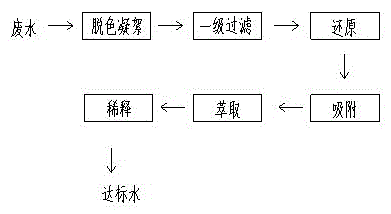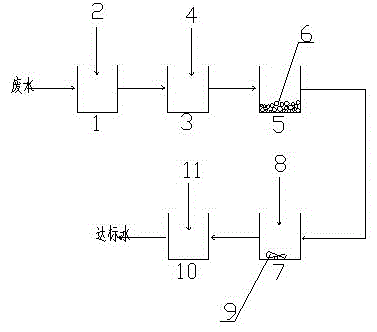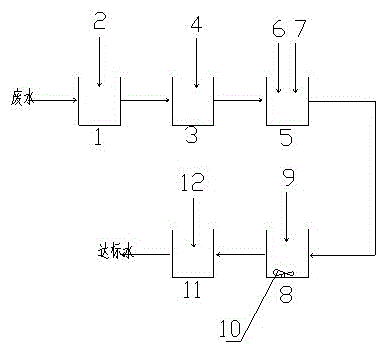Printing and dyeing wastewater treatment process
A technology for the treatment of printing and dyeing wastewater, applied in the fields of water/sewage multi-stage treatment, water/sludge/sewage treatment, chemical instruments and methods, etc. and other problems, to achieve the effect of fast ion exchange, simple extraction process and high decolorization rate
- Summary
- Abstract
- Description
- Claims
- Application Information
AI Technical Summary
Problems solved by technology
Method used
Image
Examples
Embodiment 2
[0021] Labels in the figure: 1-filter tank, 2-filter aid, 3-reduction tank, 4-sulfur-containing reducing agent, 5-hydride initiator, 6-adsorber, 7-bentonite, 8-extractor, 9- Non-water-soluble organic solvent, 10-stirrer, 11-dilution tank, 12-water.
specific Embodiment approach
[0023] In order to deepen the understanding of the present invention, the present invention will be further described below in conjunction with examples, which are only used to explain the present invention and do not constitute a limitation to the protection scope of the present invention.
[0024] Embodiment of the invention figure 2 It is a specific embodiment of wastewater treatment process, comprising the following steps:
[0025] The COD of the wastewater before treatment is 1740, the BOD is 400.0, the SS suspended matter is 460, and the chromaticity is 1000. The wastewater is injected into the filter tank 1, and the filter aid 2 is added. After the filter aid 2 is fully mixed in the wastewater, the wastewater is flocculated , through the filtration of the filter pool 1, the suspended matter is filtered out, and the remaining filtrate is mainly colored dissolved matter and fine suspended matter. The COD of the filtrate filtered out after one filtration is 426, BOD...
PUM
 Login to View More
Login to View More Abstract
Description
Claims
Application Information
 Login to View More
Login to View More - R&D
- Intellectual Property
- Life Sciences
- Materials
- Tech Scout
- Unparalleled Data Quality
- Higher Quality Content
- 60% Fewer Hallucinations
Browse by: Latest US Patents, China's latest patents, Technical Efficacy Thesaurus, Application Domain, Technology Topic, Popular Technical Reports.
© 2025 PatSnap. All rights reserved.Legal|Privacy policy|Modern Slavery Act Transparency Statement|Sitemap|About US| Contact US: help@patsnap.com



